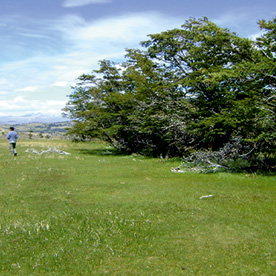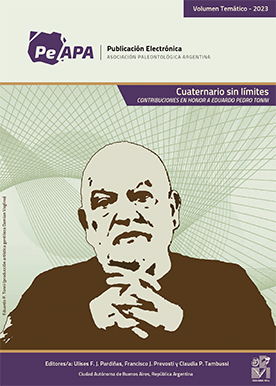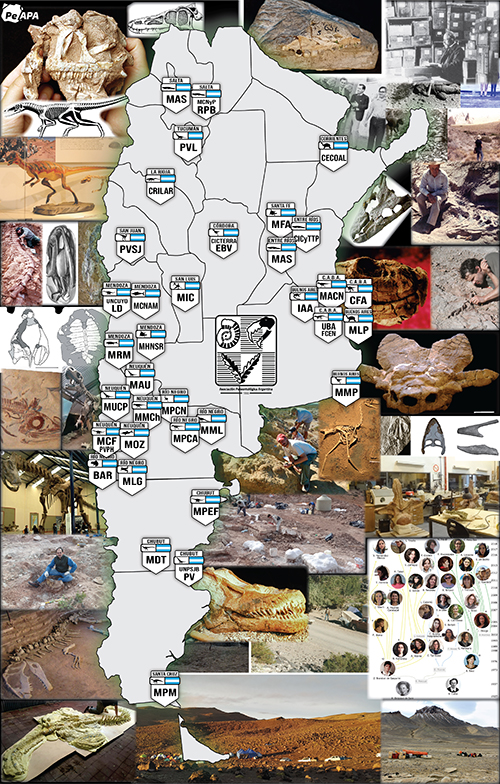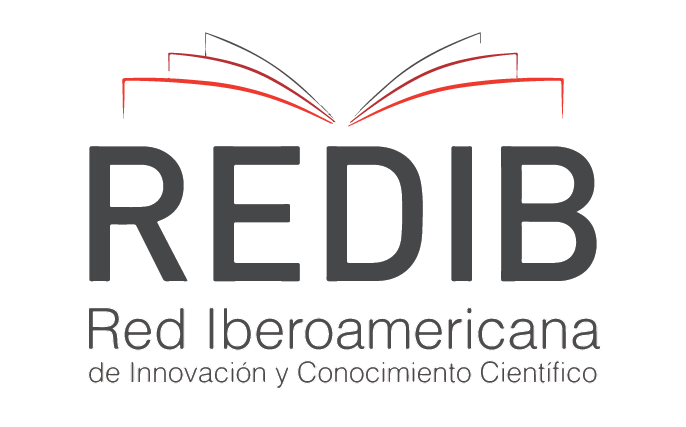UN NUEVO REGISTRO DE CONDICIONES PALEOAMBIENTALES PARA EL NORESTE DE LA CUENCA DEL LAGO SAN MARTÍN (PATAGONIA, ARGENTINA): RECONSTRUCCIÓN DE LA VEGETACIÓN A PARTIR DEL POLEN E ISÓTOPOS DE CARBONO DESDE 10.200 CAL. AÑOS AP
DOI:
https://doi.org/10.5710/PEAPA.05.01.2023.449Palabras clave:
Comunidades de vegetación, Holoceno, Análisis polínico, Isótopos de carbono, Patagonia, Humedal, Reconstrucción paleoambientalResumen
En la presente investigación reconstruimos las condiciones paleoambientales a partir de un registro sedimentario de un humedal (mallín) localizado en la estepa Patagónica cercano al bosque subantártico de la margen noreste de la cuenca del Lago San Martín (SO Santa Cruz, Patagonia, Argentina). A partir del Mallín Ñire (49° 00’ 23,5” S; 72° 13’ 34,5” O) se analizó el contenido polínico, los isótopos de carbono y estratigrafía desde los 10.200 cal. años AP. La relación con las asociaciones polínicas de muestras de sedimento superficial nos permitió interpretar cambios en el registro fósil. Entre 10.200 y 9.000 cal. años AP, inferimos una estepa graminosa-arbustiva con sub-arbustos bajo condiciones áridas, y entre los 9.000 y 6.500 cal. años AP dominó una estepa graminosa bajo un incremento en la disponibilidad de humedad. Las condiciones se tornaron más secas hasta los 4.000 cal. años AP y luego se desarrolló una estepa graminosa-arbustiva lo que sugiere un ambiente de transición como los actuales. Los últimos 1.400 cal. años AP presentaron una alta variabilidad paleoambiental. La integración con otras secuencias nos permitió interpretar los cambios regionales durante el Holoceno en relación a la disponibilidad de humedad por cambios en la precipitación relacionada a variaciones en los vientos del oeste.
Referencias
Bamonte, F. P., & Mancini, M. V. (2011). Palaeoenvironmental changes since Pleistocene-Holocene transition: Pollen analysis from a wetland in southwestern Patagonia (Argentina). Review of Palaeobotany and Palynology, 165, 103–110.
Bamonte, F. P., Mancini, M. V., Belardi, J. B., & Espinosa, S. (2013). Inferencias paleoambientales a partir del análisis polínico de sitios arqueológicos del área del lago San Martín (Santa Cruz, Argentina). Magallania, 41(1), 155–169.
Bamonte, F. P, Mancini, M. V., Sottile, G. D., Marcos, M. A., & Gogorza, C. (2015). Vegetation dynamics from Lago San Martín area (Southwest Patagonia, Argentina) during the last 6500 cal B.P. Vegetation History and Archaeobotany, 24, 267–277.
Bamonte, F. P., & Marcos, M. A. (2019). Reconstrucción de paleoambientes a partir del registro polínico de secuencias arqueológicas en el oeste de Santa Cruz: análisis de escalas y la relación con las ocupaciones humanas. In J. Gómez Otero, A. Svoboda & A. Banegas (Eds.), Arqueología de la Patagonia, el pasado en las arenas (pp. 505-516). Puerto Madryn, Instituto de Diversidad y Evolución Austral. ISBN 978-987-46578-1-7.
Bengtsson, L. & Enell, M. (1986), Chemical analysis. In B.E. Berglund (Ed.) Handbook of Holocene Palaeoecology and Palaeohydrology. John Wiley & Sons (pp 423–451). Chichester, England.
Blaauw, M., & Christen, J. A. (2011). Flexible paleoclimate age-depth models using an autoregressive gamma process. Bayesian Analysis, 6, 457–474.
Borrelli, P., & Oliva, G. (Eds.). (2001). Ganadería ovina sustentable en la Patagonia Austral. Tecnología de manejo intensivo. (272 pp). INTA, Santa Cruz, Argentina.
Brook, G. A., Franco, N. V., Ambrústolo, P. Mancini, M. V., Wang, L., & Fernández, P. M. (2015). Evidence of the earliest humans in the Southern Deseado Massif (Patagonia, Argentina), Mylodontidae, and changes in water availability. Quaternary International 363, 107–125.
Correa, M. M. (Ed.). (1999). Flora Patagónica. Parte VI: Dicotiledóneas Gamopétalas (Ericaceae a Calyceraceae). Tomo VIII. (536 pp). INTA, Buenos Aires.
Echeverría, M. E., Bamonte, F. P., Marcos, M. A., Sottile, G. D., & Mancini, M. V. (2022). Past vegetation reconstruction maps and paleoclimatic variability inferred by pollen records in southern Patagonia (Argentina) since the Late glacial-Holocene transition. Journal of South American Earth Sciences, 116, 103834.
Echeverria, M. E., Sottile, G. D, Mancini, M. V., & Fontana, S. L. (2014). Nothofagus forest dynamics and palaeoenvironmental variations during the mid and late Holocene, in southwest Patagonia. The Holocene, 24(8), 957-969.
Echeverría, M. E., Sottile, G. D., Mancini, M. V., & Fontana, S. L. (2018). New insights into postglacial vegetation dynamics and environmental conditions of Península Avellaneda, southwest Patagonia, revealed by plant macro-fossils and pollen analysis. Mires and Peat, 21, 1–18.
Faegri, K., & Iversen, J. (1989). Textbook of Pollen Analysis. 4th ed. John Wiley and Sons, New Cork. (314 pp).
Flantua, S. G. A., Hooghiemstra, H., Vuille, M., Behling, H., Carson, J. F., Gosling, W. D., Hoyos, I., Ledru, M.P., Montoya, E., Mayle, F., Maldonado, A., Rull, V., Tonello, M. S., Whitney, B. S., & González-Arango, C. (2016). Climate variability and human impact in South America during the last 2000 years: synthesis and perspectives from pollen records, Climate of the Past, 12, 483–523.
Fletcher, M. S., & Moreno, P. I. (2012). Have the Southern Westerlies changed in a zonally symmetric manner over the last 14,000 years? A hemisphere-wide take on a controversial problem. Quaternary International, 253, 32–46.
Franco, N. V., Vetrisano, L., Mancini, M. V., & Brook, G. A. (2020). Nueva información referida a la transición Pleistoceno-Holoceno y al Holoceno temprano en el extremo sur del Macizo del Deseado (Patagonia, Argentina). Revista del Museo de La Plata, 5(1), 109–125.
Fritz, P., & Fontes, J. Ch. (1980). Handbook of Environmental Isotope Geochemistry, The Terrestrial Environment A, Elsevier, Amsterdam, Vol. 1 (545pp).
Garreaud, R. D., López , R., Minvielle, M., & Rojas, M. (2013). Large-scale control on the Patagonian climate. Journal of Climate, 26, 215–230.
Guerrido, C., & Fernandez, D. (2007). Flora Patagonia. Southern forest/Bosques Australes. Fantástico Sur, Punta Arenas, Chile, (298pp)
Glasser, N. F., Harrison, S., Winchester, V., & Aniya, M. (2004). Late Pleistocene and Holocene palaeoclimate and glacier fluctuations in Patagonia. Global and Planetary Change, 43, 79–101.
Glasser, N. F., Jansson, K. N., Goodfellow, B. W., de Angelis, H., Rodnight, H., & Rood, D.H. (2011). Cosmogenic nuclide exposure ages for marains in the Lago San Martín Valley, Argentina. Quaternary Research, 75, 636–646.
Grimm, E. C. (2004). Tilia Software. Springfield, IL: Research and Collections Center, Illinois State Museum.
Heiri, O., Lotter, A., & Lemcke, G. (2001). Loss on ignition as a method for estimating organic and carbonate content in sediments: reproducibility and comparability of results. Journal of Paleolimnology, 25, 101–110.
Heusser, C. J. (2003). Ice age southern Andes: a chronicle of paleoecological events. Developments in Quaternary Science, 3. (240 pp). Elsevier, Amsterdam,
Hoefs, J. & Schidlowski, M. (1967). Carbon Isotope Composition of Carbonaceous Matter from the Precambrian of the Witwatersrand System. Science, 155, 1096–1097.
Hogg, A. G., Heaton, T. J., Hua, Q., Palmer, J. G., Turney, C. S. M., Southon, J., Bayliss, A., Blackwell, P. G., Boswijk, G., Bronk Ramsey, C., Pearson, C., Petchey, F., Reimer, P., Reimer, R., Wacker, L. (2020). SHCal20 Southern Hemisphere calibration, 0–55,000 years cal BP. Radiocarbon, 62(4),759–778.
Horta, L. R, Marcos, M. A., Bozzuto, D.L., Mancini, M.V., & Sacchi, M. (2016). Paleogeographic and paleoenviromental variations of Pueyrredón Lake Posadas - Salitroso area during the Holocene and their relationship to occupational dynamics. Palaeogeography, Palaeoclimatology, Palaeoecology, 449, 541–552.
Horta, L.R., Marcos, M.A., Sacchi, M., Bozzuto, D.L., Georgieff, S.M., Mancini, M.V., & Civalero, M.T. (2019). Paleogeographic and paleoenvironmental evolution in northwestern Santa Cruz (Argentina), and its influence on human occupation dynamics during the late Pleistocene- early Holocene. Palaeogeography, Palaeoclimatology, Palaeoecology, 516, 44–53.
Huber, U. M., & Markgraf, V. (2003). Holocene fire frequency and climate change at Rio Rubens Bog, southern Patagonia. In T.T. Veblen, W. L. Baker, G. Montenegro, T.W. & Swetnam (Eds.), Fire and Climatic Change in Temperate Ecosystems of the Western Americas (357–380 pp). New York, Springer Verlag.
Huber, U. M., Markgraf, V., & Shabitz, F. (2004). Geographical and temporal trends in Late Quaternary fire histories of Fuego-Patagonia, South America. Quaternary Science Reviews, 23, 1079–1097.
Lüning, S., Gałka, M., Bamonte, F. P., García Rodríguez, F., & Vahrenholt, F. (2018). The Medieval Climate Anomaly in South America. Quaternary International, 508, 70-87.
Mancini, M.V. (1998). Vegetational changes during Holocene in the Extra-Andean Patagonia, Santa Cruz Province, Argentina. Palaeogeography, Palaeoclimatology and Palaeoecology, 138, 207–219.
Mancini, M.V. (2002). Vegetation and climate during the Holocene in Southwest Patagonia, Argentina. Review of Palaeobotany and Palynology, 122, 101–115.
Mancini, M. V. (2009). Holocene vegetation and climate changes from a peat pollen record of the forest-steppe ecotone, Southwest of Patagonia (Argentina). Quaternary Science Reviews, 28,(15–16), 1490-1497.
Mancini, M. V., Bamonte, F. P., Marcos, M. A., Sottile, G. D., & Echeverría, M. E. (2018). Análisis y métodos paleoecológicos para la reconstrucción de comunidades de bosque y estepas de Patagonia, Argentina. In: A.R. Prieto (Ed.), Metodologías y estrategias del análisis palinológico del Cuaternario tardío. Publicación Electrónica de la Asociación Paleontológica Argentina, 18, 77–101. dx.doi.org/10.5710/PEAPA.11.07.2018.256
Mancini, M. V., de Porras, & M. E., Bamonte, F. P. (2012). Southernmost South America Steppes: vegetation and its modern pollen-assemblages representation. In M.G. Denise (Ed.), Steppe Ecosystems: Dynamics, Land Use and Conservation (pp 141–156). Nova.
Mancini, M. V., Franco, N. V., & Brook, G. A. (2013). Palaeoenvironment and early human occupation of southernmost South America (South Patagonia, Argentina). Quaternary International, 299, 13–22.
Marcos, M. A. & Mancini, M. V. (2012). Comunidades vegetales de la costa norte del Golfo San Matías, Río Negro, Argentina. Ecología Austral (pp. 188–194). Buenos Aires.
Marcos, M. A., Bamonte, F. P., Echeverría, M. E., & Mancini, M. V. (2019). Tafonomía polínica en sitios arqueológicos: relación con los efectos ambientales y con el uso de los sitios por los grupos cazadores-recolectores. In J. Gómez Otero, A. Svoboda & A. Banegas (Eds.), Arqueología de la Patagonia, el pasado en las arenas (pp. 529–542). Puerto Madryn, Instituto de Diversidad y Evolución Austral. ISBN 978-987-46578-1-7.
Marcos, M. A, Bamonte, F. P., Echeverria, M. E., & Mancini, M. V. (2020). Southern Patagonian archaeological sites (47°-49 S; 72° W, Argentina) as pollen Records: Pollen Preservation Analysis Considerations for Accurate Palaeoenvironmental Reconstructions. Journal of Anthropological and Archaeological Science, 2, 205–219.
Marcos, M. A., Bamonte, F. P., Echeverría, M. E., Sottile, G. D., & Mancini, M. V. (2022). Changes in vegetation and human-environment interactions during the Holocene in the Lake Pueyrredón area (southern Patagonia). Vegetation History and Archaeobotany, 31, 291–305.
Markgraf, V., Bradbury, P., Schwalb, A., Burns, S., Stern, Ch., Ariztegui, D., Gilli, A., Anselmetti, F., Stine, S., & Maidana, N. (2003). Holocene palaeoclimates of southern Patagonia: limnological and environmental history of Lago Cardiel, Argentina. The Holocene, 13, 581–591.
Markgraf, V., & Huber, U.M. (2010). Late and postglacial vegetation and fire history in southern Patagonia and Tierra del Fuego. Palaeogeography, Palaeoclimatology, Palaeoecology, 297, 351–366.
Moreno, P. I., Francois, J. P., Villa-Martínez, R. P., & Moy, C. M. (2009). Millennial-scale variability in Southern Hemisphere westerly wind activity over the last 5000 years in SW Patagonia. Quaternary Science Reviews, 28, 25–38.
Moreno, P. I., Simi, E., Villa-Martínez R. P., & Vilanova, I. (2019). Early arboreal colonization, postglacial resilience of deciduous Nothofagus forests, and the Southern Westerly Wind influence in central-east Andean Patagonia. Quaternary Science Reviews, 218, 61–74.
Moreno, P .I., Villa-Martínez, R. P., Cárdenas, M. L., & Sagredo, E. A. (2012). Deglacial changes of the southern margin of the southern westerly winds revealed by terrestrial records from SW Patagonia (52ºS). Quaternary Science Reviews, 41, 1–21.
Mosquera, B., & Mancini, M.V. (2021). Paleoenvironmental analysis of Deseado Massif wet meadow. Implications to the Holocene occupations of Argentinean Patagonia. The Holocene, 31. https://doi.org/10.1177/09596836211025969
Movia, C. P., Soriano, A., Leon, R. J. C. (1987) La vegetación de la cuenca del río Santa Cruz (Provincia de Santa Cruz, Argentina). Darwiniana 28(14): 9–78.
Moy, C. M., Moreno, P. I., Dunbar, R. B., Kaplan, M. R., Francois, J.-P., Villalba, R., & Haberzettl, T. (2009). Climate change in southern South America during the last two millennia. In F. Vimeux, F. Sylvestre & M. Khodri (Eds.), Past Climate Variability in South America and Surrounding Regions. Developments in Paleoenvironmental Research, 14, 353–393.
Oyarzabal, M., Clavijo, J., Oakley, L., Biganzoli, F., Tognetti, P., Barberis, I., Maturo, H. M., Aragón, R., Campanello, P.I., Prado, D., Oesterheld, M., & León, R. J. C. (2018). Unidades de vegetación de la Argentina. Ecología Austral, 28, 040-063.
Paez, M. M., Prieto, A. R., & Mancini, M.V. (1999). Fossil pollen from Los Toldos locality: a record of the Late-glacial transition in the Extra-Andean Patagonia. Quaternary International, 53–54, 69–75.
Panarello, H. O., & Sánchez, E. (1985). The Kranz syndrome in the Eragrostideae (Chloridoideae, Poaceae) as indicated by carbon isotopic ratios. Bothalia, 15, 587–590.
Panarello, H. O. (1987) Relaciones entre isótopos de elementos livianos para estudiar procesos ambientales y paleotemperaturas. Tesis Doctoral, Universidad de Buenos Aires, FCEN, Buenos Aires, Argentina, p 105.
Panarello, H. O., Sanci, R., & Wassenaar, L. I. (2018). 14C chronology and stable isotopes on Lymnaea viatrix shells in northwest Patagonia, Argentina. Do they express the Antarctic climatic reversal? Carbonates and Evaporites, 34, 133–142
Paruelo, J. M., Beltrán, A., Jobbágy, E., Sala, O., & Golluscio, R. (1998). The climate of Patagonia: general patterns and controls on biotic processes. Ecología Austral, 8, 85–101.
Peri, P. L., Ladd, B., Pepper, D. A., Bonser, S., Laffan, S. W., & Amelung, W. (2012). Carbon (δ13C) and nitrogen (δ15N) stable isotope composition in plant and soil in Southern Patagonia’s native forests. Global Change Biology, 18, 311–321.
Peri, P. L., & Ormaechea, S. (2013). Relevamiento de los bosques nativos de ñire (Nothofagus antarctica) en Santa Cruz: base para su conservación y manejo. Ediciones INTA, Buenos Aires. (pp 88).
Rojo, L. D., Mehl, A. E., Zárate, M. A., García, A., & Chivas, A. R. (2018). Late Pleistocene and Holocene vegetation changes in the arid Andean piedmont of central Argentina inferred from sediment stable carbon isotopes and C/N ratios. Palaeogeography, Palaeoclimatology, Palaeoecology, 495, 205–213.
Sánchez E., Arriaga, M. O., & Panarello, H. O. (1986). El síndrome de Kranz en Asteraceae de la Flora Argentina. Boletín de la Sociedad Argentina de Botánica, 24, 249–259
Sottile, G.D.; Bamonte, F. P.; Mancini, M. V., & Bianchi, M. M. (2012). Insights into Holocene vegetation and climate changes at the Southeastern side of the Andes: Nothofagus Forest and Patagonian Steppe fire records. The Holocene, 22(11), 1201–1214.
Sottile, G. D., Echeverría, M. E., Tonello, M. S., Marcos, M. A., Bamonte, F. P., Rayó, C., & Mancini, M. V. (2020). Dinámica de la vegetación andina del lago Argentino (49°S, 72°O) desde el retiro de los glaciares ca. 12.000 años cal AP. Andean Geology, 47(3), 599-627.
Stine, S., & Stine, M. (1990). A record from Lago Cardiel of climate change in southern South America. Nature, 345, 705–708.
Stuiver, M., & Reimer, P. J. (1993). Extended 14C database and revised CALIB radiocarbon calibration program. Radiocarbon, 35, 215–230.
Stuiver, M., Reimer, P. J., & Reimer, R.W. (2021). CALIB 8.2 [WWW program] at http://calib.org.
Tessone, A., & Belardi, J. B. (2010). Evaluación del δ13C y δ15N en el colágeno de herbívoros de las cuencas de los lagos Tar y San Martín (provincia de Santa Cruz, Patagonia). In M. A. Gutiérrez, M. De Nigris, P. M. Fernàndez, M. Giardina, A. Gil, A. Izeta, G. Neme & H. Yacobaccio (Eds.), Zooarqueología a principios del siglo XXI. Aportes teóricos, metodológicos y casos de estudio. (pp 345–357). Buenos Aires, Ediciones Espinillo.
Tessone, A., Fernández, P., Fernández, N., & De Nigris, M. (2020a). Variaciones δ13C y δ15N en huemul durante el Holoceno en Cerro Casa de Piedra, Santa Cruz, Argentina. Implicancias para el estudio de su distribución pasada. Intersecciones en Antropología, 21(1), 5–16.
Tessone, A., Miotti, L., Marchionni, L., Hermo, D., & Mosquera, B. (2020b). δ13C y δ15N de fauna proveniente de sitios arqueológicos del Macizo del Deseado, Santa Cruz, Argentina. Magallania, 48(1), 123–140.
Tessone, A., 2022. Constructing an isotope ecology in southern Patagonia: Herbivore δ13C and δ15N variability from the Andes to Atlantic coast. Quaternary International, 628, 79–87.
Tonello, M. S., Mancini, M. V., & Seppä, H. (2009). Quantitative reconstruction of Holocene precipitation changes in southern Patagonia. Quaternary Research, 72, 410–420.
Vilanova, I., Moreno, P. I., Miranda, C. G., & Villa-Martínez, R. P. (2019). The last glacial termination in the Coyhaique sector of central Patagonia. Quaternary Science Reviews, 224, doi.org/10.1016/j.quascirev.2019.105976.
Villa-Martínez, R. P., & Moreno, P. I. (2007). Pollen evidence for variations in the southern margin of the westerly winds in SW Patagonia over the last 12,600 years. Quaternary Research, 68, 400–409.
Villa-Martínez, R. P., Moreno, P.I., & Valenzuela, M.A. (2012). Deglacial and postglacial vegetation changes on the Eastern slopes of the central Patagonian Andes (47°S). Quaternary Science Review, 32, 86-99.
Wille, M., & Schäbitz, F. (2009). Late-glacial and Holocene climate dynamics at the steppe/forest ecotone in southernmost Patagonia, Argentina: the pollen record from a fen near Brazo Sur, Lago Argentino. Vegetation History and Archaeobotany, 18, 225-234.

Archivos adicionales
Publicado
Número
Sección
Licencia
Derechos de autor 2023 Florencia Paula Bamonte, María Alejandra Marcos, Marcos Emanuel Echeverría, Gonzalo David Sottille, Héctor Osvaldo Panarello, María Virginia Mancini

Esta obra está bajo una licencia internacional Creative Commons Atribución-SinDerivadas 4.0.

Los/las autores/as conservan los derechos de autor/a y garantizan a la revista el derecho de ser la primera publicación del trabajo licenciado bajo una licencia CC Attribution-NonCommercial 4.0 que permite a otros/as compartir el trabajo con el reconocimiento de la autoría y de la publicación inicial en esta revista.




















